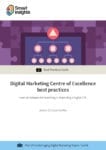Agile digital marketing: It's time to consider how focusing on agility can reenergize your marketing efforts.
As a marketer, you are probably familiar with the traditional waterfall process. This is where your team creates monthly, quarterly, and yearly plans comprised of a series of initiatives to launch throughout the year. While it is straightforward, this approach still makes it difficult to foresee the market pulse from 12 or even six months out. As a result, this lack of predictability can derail workflows.
True, the waterfall process has certain advantages, such as the ability to meticulously plan details, establish timelines, and delegate duties, but as a marketing professional, you should also consider using an agile approach. With agile digital marketing, your team works in sprints, as well as adjusts and optimizes shorter campaigns to reflect current market conditions. In addition, the highest-value campaigns always rise to the top of the priority list.
When it comes to doing business in today’s dynamic marketplace, agility is paramount. For example, had Toys R Us elected to pursue an agile strategy, the company might still be in business today. Instead, the now-extinct brand signed a 10-year contract with Amazon to be the platform’s exclusive toy vendor. As a result, the company put off its own e-commerce innovation methods, leaving its team in a stalled state when the contract prematurely ended four years later.
If you're worried that your business might be following a similar path, it's time to consider how a new focus on agility can reenergize your marketing efforts.
The path to agility
Despite the appeal of agile digital marketing, it's crucial to understand whether the process is best for your company. When I was deciding what approach worked best for our marketing team, I considered my answers to the following questions:
Do you have more than three people on your team? Agile frameworks yield greater results with larger teams.
Does your team work as a unit toward common goals, or do you have individual priorities and projects? If the latter is true, stick with a waterfall approach. Agile marketing is more effective when individuals with unique skill sets collaborate to produce a campaign together.
Is your project owner readily available to the team? If the person with all the answers is difficult to reach, your ability to produce work quickly will suffer, and an agile approach will be less successful.
Does your team require detailed processes or workflows to complete a project, or can it quickly adapt when new ideas emerge? Being agile is all about efficiency, so getting stuck in an outdated process will impede your ability to innovate.
Are you willing to make time for retrospectives, or is it essential that you move on immediately to the next project? Being agile requires inspection and adaptation. If you can't make time to regularly evaluate how your work could improve, you are not committing to an agile approach.
The agile framework provides numerous advantages, but it still requires a lot of work. One of the biggest struggles we’ve faced is our relative lack of retrospectives.
Because we all work on multiple initiatives on any given day, it’s a struggle to analyze our work before charging off to the next campaign. Fortunately, we’ve recognized this and are working diligently to correct it.
5 steps to launch more agile digital marketing campaigns
Now, if you've determined that an agile digital marketing approach is best for your team, it's time to dive into the steps of implementation:
1. Know your stuff
You’re already taking the first step toward adopting an agile process by having initial interest and an open mind. Continue to research the topic and learn best practices from the people and organizations that excel at agility. For those who are adamant about implementing an agile approach, complete a Scrum Master Certification course with your team to ensure everyone is operating on the same wavelength.
2. Ask your stakeholders
Consult with your team members about which agile or scrum frameworks they want to implement. To be agile, your team will need to self-organize. Start by coming to a consensus about how you want to be agile. Schedule group meetings or one-on-one sessions with colleagues to flesh out these ideas. Take notes and find the similar areas individuals want to improve in — knowing where you need to grow pushes you forward into becoming an effective agile team.
3. Implement tools
Adopt a project management tool to track your team’s progress. At Pantheon, we use Asana, but Trello and Jira are also solid options. On the other hand, you can take a simpler route and just use colorful Post-it notes on a whiteboard. Remember that project management revolves around breaking large projects into small tasks. So once you make those tasks, decide as a group how you want to organize check-ins and overall communication to keep the team running smoothly.
4. Stay accountable
Schedule regular meetings to delegate responsibility, discuss work, bring up any outstanding obstacles, and evaluate your results. These check-ins could last 15 minutes, or they could even last up to two hours if you're looking for a more complete retrospective. Hold yourself and your team accountable and don’t miss these meetings — your ability to function cohesively depends on this time of collaboration.
5. Refine and adjust
The workflows you establish at the outset of your transition shouldn’t be the same ones your team has in place a year or even a few months from now. Instead, strive to constantly refine your frameworks in order to eliminate wasted time and resources. To do this, make sure to enable innovation from all participants, and empower your team to create the highest-value campaigns possible.
No matter the industry, success in business requires a forward-thinking approach that prioritizes innovation and change. If that description doesn’t match your current marketing strategy, the time to evolve is now — and an agile digital marketing approach could be your best solution.
 As the director of online marketing, Sarah Fruy leads the strategy, goals, and road map for Pantheon's public-facing website and online programs. Fruy is a Certified ScrumMaster® and joins Pantheon with over 10 years of experience in the marketing, digital publishing, and online advertising industries, along with marketing strategy and digital marketing certifications from Cornell Johnson Graduate School of Management.
As the director of online marketing, Sarah Fruy leads the strategy, goals, and road map for Pantheon's public-facing website and online programs. Fruy is a Certified ScrumMaster® and joins Pantheon with over 10 years of experience in the marketing, digital publishing, and online advertising industries, along with marketing strategy and digital marketing certifications from Cornell Johnson Graduate School of Management.




 As the director of online marketing,
As the director of online marketing, 


